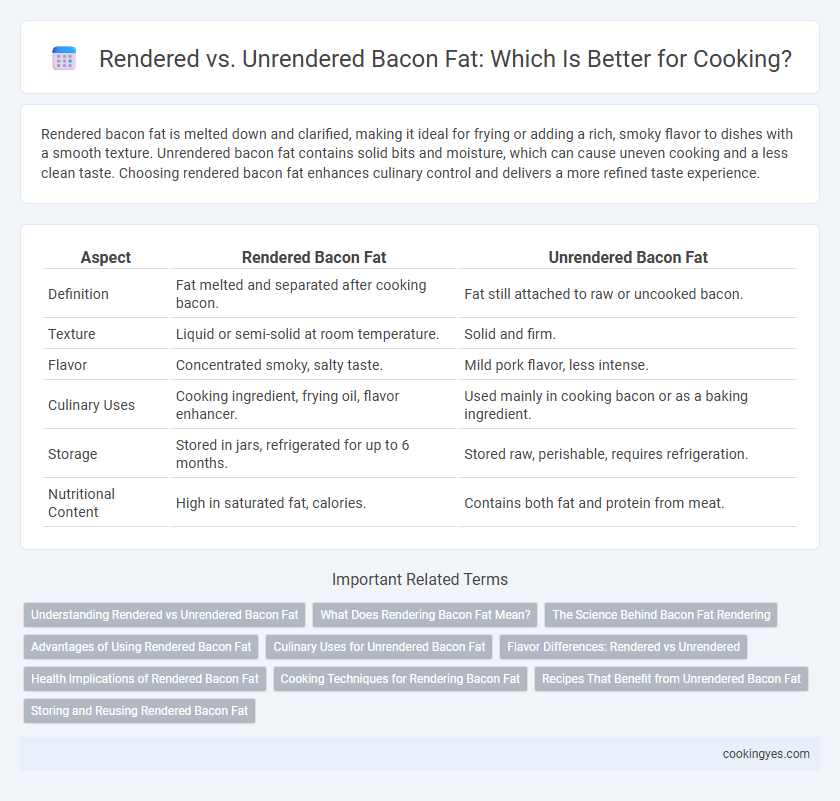Rendered bacon fat is melted down and clarified, making it ideal for frying or adding a rich, smoky flavor to dishes with a smooth texture. Unrendered bacon fat contains solid bits and moisture, which can cause uneven cooking and a less clean taste. Choosing rendered bacon fat enhances culinary control and delivers a more refined taste experience.
Table of Comparison
| Aspect | Rendered Bacon Fat | Unrendered Bacon Fat |
|---|---|---|
| Definition | Fat melted and separated after cooking bacon. | Fat still attached to raw or uncooked bacon. |
| Texture | Liquid or semi-solid at room temperature. | Solid and firm. |
| Flavor | Concentrated smoky, salty taste. | Mild pork flavor, less intense. |
| Culinary Uses | Cooking ingredient, frying oil, flavor enhancer. | Used mainly in cooking bacon or as a baking ingredient. |
| Storage | Stored in jars, refrigerated for up to 6 months. | Stored raw, perishable, requires refrigeration. |
| Nutritional Content | High in saturated fat, calories. | Contains both fat and protein from meat. |
Understanding Rendered vs Unrendered Bacon Fat
Rendered bacon fat is clarified by cooking bacon slowly to melt and separate the fat from solids, resulting in a clear, liquid fat ideal for frying and flavoring dishes. Unrendered bacon fat contains both melted fat and solid bits, offering a richer texture but less versatility for high-heat cooking. Understanding this difference helps chefs choose the appropriate form based on texture, cooking temperature, and flavor intensity required in recipes.
What Does Rendering Bacon Fat Mean?
Rendering bacon fat means slowly cooking raw bacon to melt and separate the fat from the meat, resulting in clear, golden liquid fat used for cooking. Rendered bacon fat enhances flavor and can be stored for future use, unlike unrendered fat found directly on uncooked bacon strips. This process improves texture and maximizes the culinary value of bacon fat in recipes.
The Science Behind Bacon Fat Rendering
The science behind bacon fat rendering involves heating raw bacon fat to separate the solid components from the liquid oil by melting the fat cells at specific temperatures, typically around 130-150degF (54-65degC). Rendered bacon fat is the purified liquid fat obtained after this process, known for its rich flavor and high smoke point, ideal for cooking and frying. Unrendered bacon fat contains solid bits and connective tissue, resulting in a denser texture and lower culinary versatility compared to fully rendered fat.
Advantages of Using Rendered Bacon Fat
Rendered bacon fat offers a clean, smooth texture ideal for cooking and frying, enhancing flavor without the grittiness of unrendered fat. It has a longer shelf life and higher smoke point, making it more versatile for various culinary applications. Using rendered bacon fat also provides concentrated savory notes while reducing impurities and water content compared to unrendered fat.
Culinary Uses for Unrendered Bacon Fat
Unrendered bacon fat, also known as raw or fresh bacon fat, contains a higher moisture content and solid bits of meat, making it ideal for slow-cooking methods where its flavor can infuse ingredients without burning. Chefs use unrendered bacon fat to add richness and a smoky aroma in stews, braises, and slow-roasted vegetables, capitalizing on its ability to slowly release flavor. Its versatile texture allows it to blend seamlessly into doughs or batters, enhancing savory baked goods with authentic bacon taste.
Flavor Differences: Rendered vs Unrendered
Rendered bacon fat offers a smoother, more concentrated flavor profile with a rich, savory taste ideal for cooking, while unrendered bacon fat retains a stronger, raw pork essence and a chewier texture that can be more intense and less versatile. The rendering process melts out impurities and water, intensifying the fat's aromatic qualities and reducing bitterness, resulting in a cleaner, more pleasant flavor. Chefs often prefer rendered bacon fat for sauteing and frying due to its enhanced flavor and higher smoke point compared to unrendered fat.
Health Implications of Rendered Bacon Fat
Rendered bacon fat, which is melted and separated from the solid bits, contains higher concentrations of healthy monounsaturated fats like oleic acid, supporting heart health and reducing inflammation. Unrendered bacon fat retains more solid particles and impurities, which may contribute to higher levels of saturated fats and potentially increase cholesterol levels. Choosing rendered bacon fat for cooking can provide clearer, purer fat with better nutritional properties and improved digestibility.
Cooking Techniques for Rendering Bacon Fat
Rendered bacon fat is achieved by slowly cooking bacon over low to medium heat, allowing the fat to melt and separate from the meat, resulting in a clear, golden liquid perfect for frying and sauteing. Unrendered bacon fat remains within the solid fat and connective tissue, commonly found in raw or partially cooked bacon, offering a chewier texture and less liquid fat output. Proper rendering technique ensures maximum flavor extraction and crispier bacon, making it ideal for incorporating bacon fat into recipes that require a rich, smoky flavor.
Recipes That Benefit from Unrendered Bacon Fat
Unrendered bacon fat, which contains small bits of meat and connective tissue, provides intense smoky flavor and a unique texture ideal for recipes like cornbread, savory biscuits, and sauteed greens. This type of fat enhances dishes by adding rich umami and a slight crunch, distinguishing it from fully rendered fat that is purely liquid and smooth. Chefs often prefer unrendered bacon fat in recipes where flavor complexity and texture contribute significantly to the overall taste experience.
Storing and Reusing Rendered Bacon Fat
Rendered bacon fat, collected after cooking, should be strained and stored in an airtight container in the refrigerator to maintain freshness and prevent rancidity. Unrendered bacon fat, which contains solid bits and moisture, is less suitable for long-term storage and can spoil quickly. Reusing properly stored rendered bacon fat enhances flavor in cooking while reducing waste and preserving its rich, smoky essence.
Rendered vs Unrendered for Bacon Fat Infographic

 cookingyes.com
cookingyes.com